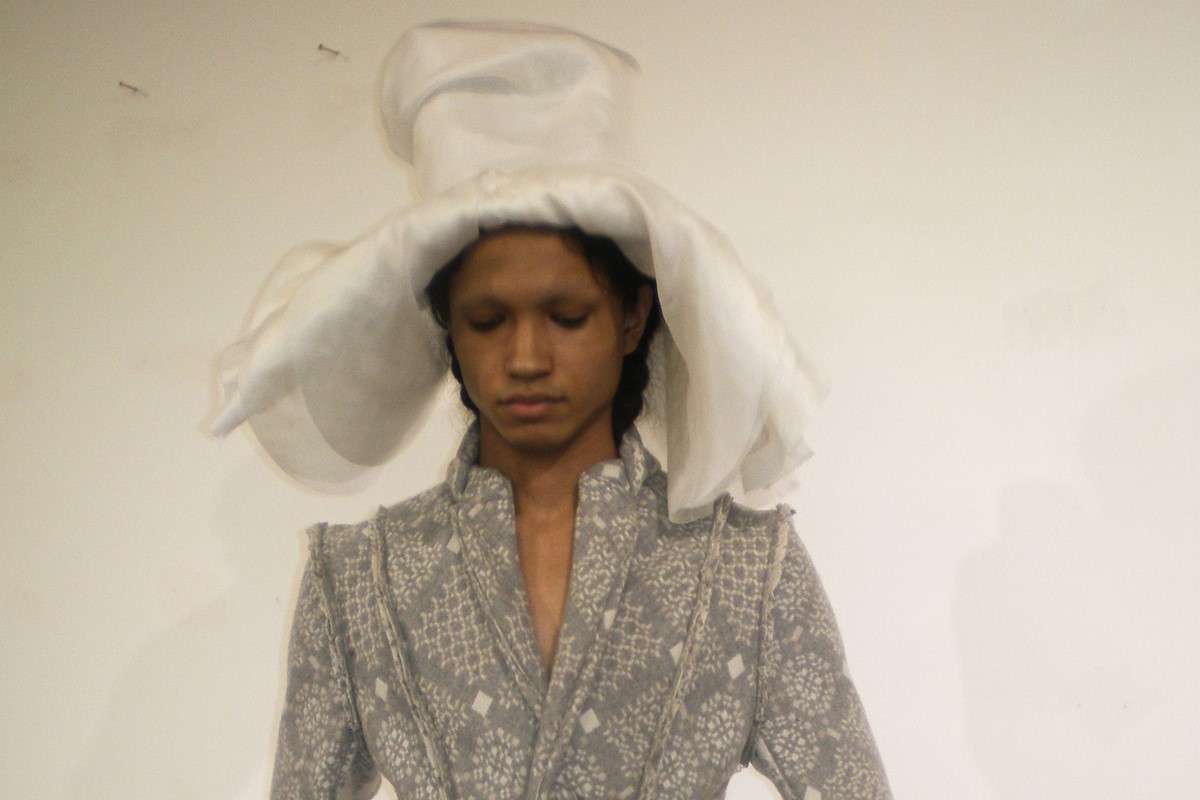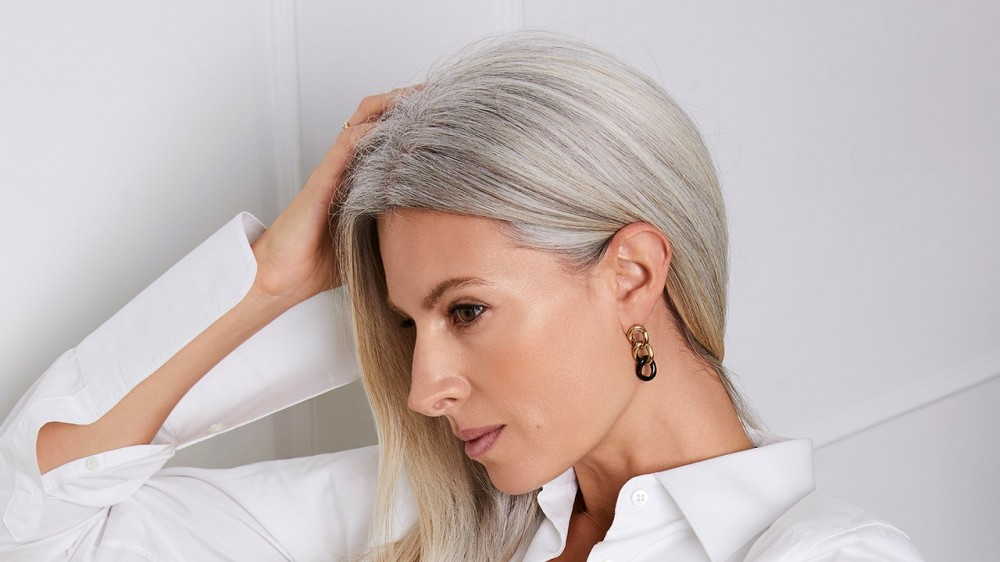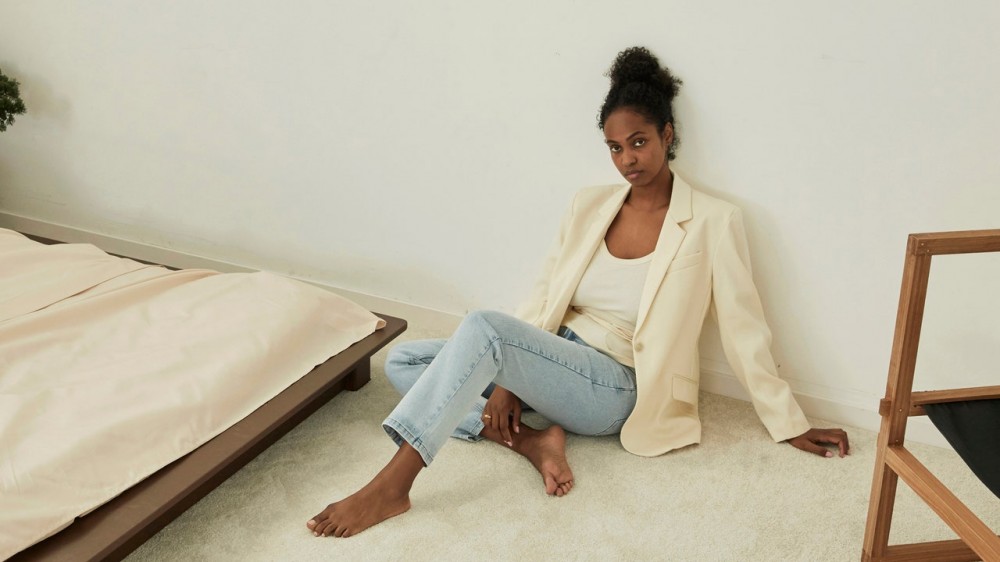
Paolo Carzana is the pilgrim designer sent to heal the needy
Critics have compared him to the fashion greats, but who is this rising designer, and why is he set to be ‘the one to change it all?’
“Sorry, this is the longest cigarette I’ve ever had,” says Paolo Carzana, who has been smoking a cigarette for about 30 seconds. It’s 9am and he’s standing outside the entrance of his studio at Alexander McQueen’s Sarabande Foundation. But with just three days to go until his next presentation at London Fashion Week, he’s beginning to lose purchase on his words – and his 4G connection. The screen glitches, his voice lags, the signal cuts out, he takes accidental screenshots, and stops to corral his team into various rooms. “Ugh, I haven’t been to sleep, which is why I’m a bit delirious. I’ve still got a casting to get through this morning and then a styling session this afternoon, so I’m feeling quite stressed, sorry.”
A storybook of Welsh mythologies, where faerie guides, changelings, and medicinal plants are an ambient part of the everyday, Carzana’s collections are the work of a pilgrim designer – of someone who approaches fashion not only as a site of radical transformation, but of quiet and profound healing. His name first attracted intrigue at Westminster University, where a brooding and organically-sourced showcase laid the foundations for an MA at Central Saint Martins, paid for by Kering and LVMH. Following his breakout collection last summer, Sarah Mower described Carzana as “a visionary” and “a wonder to the fashion world”, likening his outlier talent to McQueen and John Galliano. A couple of months later, he secured a place on the British Fashion Council’s prestigious NEWGEN incubator – and then, life as he knew it began to cave in on itself.




“How emotional do you want me to get here,” he stops mid-sentence. “Because there have been a lot of obstacles.” As Carzana leads me – or rather, his iPhone – through a pair of paddock gates, past a cobblestone courtyard, and into the intestines of the Sarabande, the past couple of years finally come into focus. “When I graduated from my MA it was just before the pandemic started, so I moved back to Cardiff for what ended up being a year and a half. And I hated it. There was no creative community to make me feel sane with what I was doing. So I created a collection, alone in lockdown, that was based on all these characters I had imagined were protecting me. Then, as soon as I moved back to London, I fell ill for six months. I started to get all types of different infections and had to go for constant scans. I think I had ten courses of antibiotics in two months,” he says. “I think it was rooted in stress.”
“Weirdly I’ve reached a very hopeful and happy space, and today’s collection feels like the ending of the beginning.” Carzana’s practice has always been an intensely personal one, running the proverbial film backward and reconstructing some of his most vulnerable moments – like “being on the receiving end of an abuse of power”, which gave way to exoskeletal suit jackets looming over boyish models in his BA collection. “It was made to look like someone was puppeting my decisions and feelings,” he says, but all those imposing figures have now faded into what he calls “guardian angels”, free-floating behind this season’s cast in silhouettes of gossamer organza. On their feet, meanwhile, are shoes borrowed from McQueen. “The whole thing is dedicated to Lee, I want him to ground the models and give them strength because Sarabande very much saved my life. It enabled me to keep on fighting.”
The show’s title – Imagine We Could Be The Ones To Change It All – was taken from a mindless scribbling that Carzana had jotted down in his BA portfolio in 2018. “It actually got picked-up by Sarah and became the title of our Vogue interview, and then I think i-D used it as a cover line, so I’m guessing I’m reclaiming the phrase,” he says, with a laugh. “I didn’t fully understand it back then but I really feel it now. I guess it’s all-encompassing of how I want to behave.” Following an imagined 24-hour period, today’s collection travels through droopy and densely-layered outerwear in the kind of black so dark that it’s meant to invoke pain, before giving way to delicate ecru two pieces, pebble-hued tapestry coats, and stark white “open heart” shirts that look as though they might disintegrate at the touch. “I’ve been far more sensitive with the cutting because this time it’s all about strength and fragility.”
Bamboo, organic cotton, and pineapple leather is frayed, whorled, and nipped-in at the torso, while tactile creases branch out across slack-lined coats as if to trace the nervous system. “It all looks a bit crap but I promise in person it’s better,” he says. “This is the hardest I’ve ever worked, but it’s probably the worst presentation you’ve ever had in your life.” Even despite the critical acclaim, Carzana is the last to recognise just how unusual his talent really is. “What Paolo creates is sublime,” says Nasir Mazhar, his former MA tutor, who has created a couple of Welsh bonnets for the show. “The cut of the garments, fabrics hand-dyed using natural ingredients and therapeutic oils which hold healing powers, completely handmade with the most sensual touch and imagination. He is an absolute visionary. He is the future of luxury fashion.”
Clothes, for Carzana, are dressings to bind a wound, with each and every detail harbouring some kind of symbolic resonance – and to a near obsessive degree. Obviously, that’s not the only way to make clothes – it was Phoebe Philo who said “I wanted to make a pair of trousers that made my arse look good, rather than a pair that represented the Holocaust or something” – but he believes it’s endemic to good design. “Ultimately, if you’re creating something then of course it’s going to have meaning. Even if it’s just the weight of the fabric and how that’s going to keep you warm. Sorry that’s not very poetic, but I think it’s true.” It goes without saying, then, that within Carzana’s SS23 collection, is a pre-determined system of semiotics: there’s a “tender” prologue, a Pasolini-devoted chapter, a forza (Italian for strength) chapter, a brueder (Welsh for fragility) chapter, and a “guardian” epilogue.
The comparisons that have been drawn between Carzana and the likes of McQueen and Galliano aren’t just speculative: all of them are working class designers who made it their business to prove that “finance isn’t the be all and end all.” Outside of the studio, Carzana has worked with an outreach programme committed to broadening access to the arts among low-income teenagers. “It’s about encouraging them not to give up, but then I’d go back to CSM and other students had paid-for pattern-makers and seamstresses. It felt like such a lie, so when I did my MA I made it a point to make every single garment myself. I didn’t even use the school technicians because I wanted to show that you can do it yourself.” Carzana knows the value in this kind of mentorship better than most, describing art as his “saviour” in school. “I was bullied, like, every single day and so at lunchtimes I’d go to art class and my teachers would show me books on McQueen, Philipp Treacy, and the Antwerp Six.”

“I never would have found out about those people till much, much later in life,” he adds. “I believe in hard work and not giving up and kindness, but also that people – or things – are definitely looking out for you, whatever that means… I’ve experienced it.” As Carzana storms back across the gardens of the Sarabande, garment bags lugged over his shoulder, face fading into a cluster of pixels, I ask where these fascinations with protection and vulnerability might come from. “That’s a big question and an answer for another time,” he says. “But I think family and class give someone a certain sensitivity. I’m happy to wait to tell that story, though. I’m not ready to give everything up to everyone just yet.”



